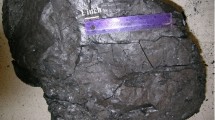Summary
The gas permeability of a coalbed, unlike that of conventional gas reservoirs, is influenced during gas production not only by the simultaneous changes in effective stress and gas slippage, but also by the volumetric strain of the coal matrix that is associated with gas desorption. A technique for conducting laboratory experiments to separate these effects and estimate their individual contribution is presented in this paper. The results show that for a pressure decrease from 6.2 to 0.7 MPa, the total permeability of the coal sample increased by more than 17 times. A factor of 12 is due to the volumetric strain effect, and a factor of 5 due to the gas slippage effect. Changes in permeability and porosity with gas depletion were also estimated using the measured volumetric strain and the matchstick reservoir model geometry for flow of gas in coalbeds. The resulting variations were compared with results obtained experimentally. Furthermore, the results show that when gas pressure is above 1.7 MPa, the effect of volumetric strain due to matrix shrinkage dominates. As gas pressure falls below 1.7 MPa, both the gas slippage and matrix shrinkage effects play important roles in influencing the permeability. Finally, the change in permeability associated with matrix shrinkage was found to be linearly proportional to the volumetric strain. Since volumetric strain is linearly proportional to the amount of gas desorbed, the change in permeability is a linear function of the amount of desorbing gas.
Similar content being viewed by others
References
Cervik, J. (1977) The behavior of coal-gas reservoirs, Paper presented at the SPE-AIME Eastern Regional Meeting, Pittsburgh, PA.
Ertekin, T.et al. (1986) Dynamic gas slippage: a unique dual-mechanism approach to the flow of gas in tight formations,SPE Formation Evaluation, 43–52.
Gash, B.W. Measurement of rock properties in coal for coalbed methane production. SPE 22909, Paper presented at the66th Annual Technical Conference and Exhibition of the SPE.
Gash, B.W.et al. (1992) The effects of cleat orientation and confining pressure and cleat porosity, permeability, and relative permeability in coal, Paper presented at theSPWLA/SCA Symposium, Oklahoma City, 15–16 June.
Gray, I. (1987) Reservoir engineering in coal seams: Part I — The physical process of gas storage and movement in coal seams,SPE Reservoir Engineering, 28–34.
Green, T.K.et al. (1985) Coal swelling inn-amines andn-alcohols,American Chemical Society,30, 488–92.
Gregg, S.J. (ed.) (1961)The surface chemistry of solids. Reinhold, New York, pp. 830–9.
Harpalani, S. and McPherson, M.J. (1985) Effect of stress on permeability of coal,Quarterly Review of Methane from Coal Seams Technology,3, 23–8.
Harpalani, S. and Schraufnagel, R. (1990) Shrinkage of coal matrix with release of gas and its impact on permeability of coal,Fuel,69, 551–6.
Harpalani, S. and Chen, G. (1992) Effect of gas production on porosity and permeability of coal,Proceedings of the Symposium of Coalbed Methane R and D in Australia, Townsville, Australia, pp. 67–73.
Hyman, L.A.et al. (1991) Simultaneous determination of capillary pressure and relative permeability in coalbed methane reservoirs,Proceedings of the 1991 Coalbed Methane Symposium, Tuscaloosa, Alabama, pp. 85–95.
King, G.R. (1985) Numerical Simulation of the Simultaneous Flow of Methane and Water Through Dual Porosity Coal Seams During the Degasification Process, Ph.D. Dissertation, Pennsylvania State University.
King, G.R. (1994)Quarterly Review of Methane from Coal Seams Technology,11, and 4, iii.
Klinkenberg, L.J. (1941) The permeability of porous media to liquids and gases,API Drilling and Production Practices, 200–13.
Law, B.E. and Rice, D.D. (eds) (1993)Hydrocarbons from Coal, AAPG, Tulsa, Oklahoma, 119–32.
Moffat, D.H. and Weale, K.E. (1955) Sorption by coal of methane at high pressures,Fuel,34, 449–62.
Patching, T.H. (1970) The retention and release of gas in coal — a review.Canadian Mining and Metallurgical Bulletin,63, 1302–8.
Patton, H.F.et al. (1994) Simulator for degasification, methane emission prediction and mine ventilation,Mining Engineering,46, 341–5.
Puri, R. and Seidle, J. (1991) Measurement of stress dependent permeability in coals and its influence on coalbed methane production.Proceedings of the 1991 Coalbed Methane Symposium, Tuscaloosa, Alabama, pp. 415–24.
Puri, R.et al. (1991) Measurement of coal cleat porosity and relative permeability characteristics.Proceedings of the SPE Gas Technology Symposium, pp. 93–104, SPE 21491.
Randolph, D.J.et al. (1984) Porosity and permeability of tight sands, SPE 12836, Paper presented at theSPE/DOE/GRI Unconventional Gas Recovery Symposium, Pittsburgh.
Reiss, L.H. (1980)The Reservoir Engineering Aspects of Fractured Formations, Editions Technip, France.
Reucroft, P.J.et al. (1983) Surface area and swellability of coal,Fuel,62, 279–84.
Reucroft, P.J.et al. (1986) Gas-induced swelling in coal,Fuel,65, 816–20.
Seidle, JP.et al. (1992) Application of matchstick geometry to stress dependent permeability in coals, inProceedings of the SPE Rocky Mountain Regional Meeting, Casper, Wyoming, pp. 433–45, SPE 24361.
Sethuraman, A.R.et al. (1987) Gas and vapor induced coal swelling,American Chemical Society,32, 259–64.
Somerton, W.H.et al. (1975) Effect of stress on permeability of coal.International Journal of Rock Mechanics Mining Science and Geological Abstracts,12, 129–45.
Stefanska, C.G. (1990) Influence of carbon dioxide and methane on changes of sorption, and dilatometric properties of bituminous coals,Archiwum Gornictwa,35, 105–13.
Van Krevelin, D.W. (1981)Coal. Elsevier, Amsterdam.
Young, G.et al. (1991) An analysis of Fruitland coalbed methane production, Cedar Hill Field, Northern San Juan Basin. SPE 22913, Paper presented at the66th ATCE of the SPE.
Zimmerman, R.W. (1991)Compressibility of Sandstones, Elsevier, New York.
Zuber, M.D. and Kuuskraa, V.A. (1989) A reservoir simulator-based methodology for calculating reserves of coalbed methane wells, inProceedings of the 1989 Coalbed Methane Symposium, Tuscaloosa, Alabama, pp. 157–66.
Zuber, M.D.et al. (1990) Simulators analyze coalbed methane,American Oil and Gas Reporter, 40–4.
Author information
Authors and Affiliations
Rights and permissions
About this article
Cite this article
Harpalani, S., Chen, G. Influence of gas production induced volumetric strain on permeability of coal. Geotech Geol Eng 15, 303–325 (1997). https://doi.org/10.1007/BF00880711
Received:
Accepted:
Issue Date:
DOI: https://doi.org/10.1007/BF00880711




